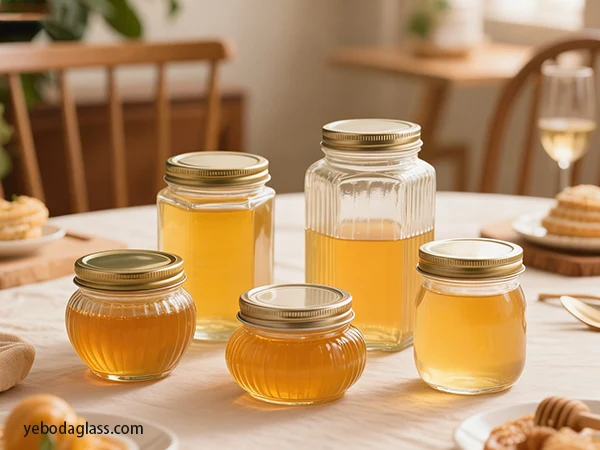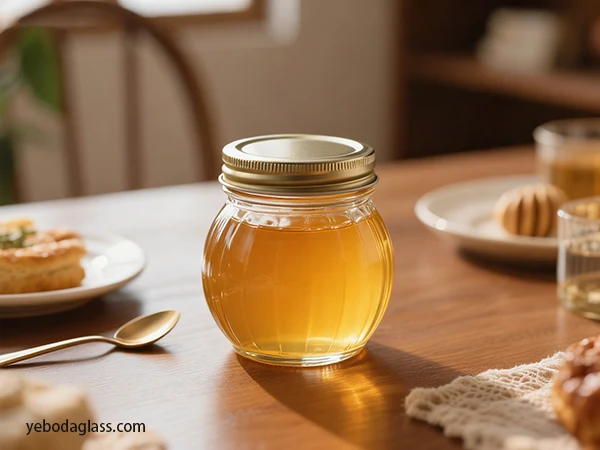エグゼクティブサマリー
このレポートでは、以下のことによる潜在的なコスト削減について徹底的に分析しています。 蜂蜜瓶(大量) サプライチェーンフレームワークと組み合わせて使用します。コスト削減にとどまらず、レポートでは、製品の品質、規制遵守、運用の信頼性を損なうことなく総コストの削減を達成する戦略を特定しています。この調査では、サプライヤーの選択、数量集約、材料の革新、設計効率、物流の最適化、サプライヤーとの長期的な協力など、コスト管理のさまざまな側面を深く掘り下げています。この調査の主な目的は、パッケージのバイヤーとメーカーに、ガラス製ハニージャーの調達業務全体で大幅なコスト削減を実現できる、洞察に富んだ実用的なソリューションを提供することです。レポートではまた、持続可能な調達慣行と、そのための新しいテクノロジーの導入の重要性を強調しており、これにより、現在だけでなく将来においてもコスト効率、製品パフォーマンス、環境への配慮が保証されます。

Current Operational Baseline
調達コンテキスト
現在の蜂蜜瓶の大量調達体制は、主に様々な製品カテゴリーや地域にまたがる大量注文への対応に重点を置いています。需要は季節によって変化し、蜂蜜生産者やプライベートブランドも多様であるため、注文パターンは多少不規則になります。第一に、統一された外観を持ち、すべての食品安全規制に準拠した、標準品質のリサイクル可能なガラス瓶を常に確保することです。
数量と製品構成
通常、標準的な250ml、500ml、1リットルのガラス製蜂蜜瓶の年間購入量は4,000万個を超えることがあります。特に第2四半期と第4四半期の繁忙期には、月間注文数が倍増し、500万個に達することもあります。サイズ、色(透明ガラスまたは琥珀色ガラス)、蓋の種類(金属製のツイストオフ式または木製)の変更は、調達と在庫管理の難しさにつながります。
規制および品質要件
It is mandatory that all jars conform to international food packaging criteria like FDA 21 CFR, EU 1935/2004, and ISO 9001 certified manufacture. Besides, the observance of hygiene and traceability rules will lead to higher production and recording costs, whereas the recyclability and eco-friendly standards, which are at the same time, continue to affect both the design and the sourcing options of the jars.
Procurement and Supplier Relationship Optimization
Strategic Sourcing and Volume Aggregation
If the purchasers decide to pool the demands between the factories and distribution centers, they can achieve a better price and delivery terms for honey jars bulk orders. The aggregation permits larger and more predictable orders, thus, the suppliers offer you discounts and, at the same time, they improve service reliability.
- Centralized Procurement: Consolidating the orders for different sizes and models of glass honey jars empowers negotiation with a stronger position.
- Long-Term Volume Contracts: Committing to multi-year contracts with definite volume clauses provides the possibility for suppliers to plan the productions more efficiently, thus, they can offer you lower per-unit costs.
- Tiered Pricing Structures: The implementation of a tiered pricing model that is based on the yearly purchase volume is a method that suppliers will follow to provide incremental discounts as the volume of orders increases.
- Strategic Supplier Consolidation: Relying on a smaller number of highly efficient glass jar manufacturers not only improves the quality of the products but also maximizes the purchasing power.
Supplier Relationship Management
Changing the connection with suppliers from purely transactional to collaborative relationship can lead to supplier innovations, better supply reliability, and discovering cost-saving opportunities together.
- Preferred Partner Programs: Identify those suppliers that are able to meet the set standards of quality, sustainability, and delivery. Innovators should be rewarded, for example, in terms of recyclability or lightweighting.
- Joint Cost Reduction Projects: Organize co-development initiatives to remove waste, recycle packaging more efficiently, and decrease transportation costs.
- Performance-Based Contracts: Establish KPIs related to areas such as on-time delivery, product quality, and response time to guarantee supplier involvement and responsibility continuously.
Material Comparison Table for Honey Jars Bulk
To aid in decision-making for honey jar bulk procurement, the following table summarizes the key attributes of the primary materials:
| 特徴 | ガラス | PET(ポリエチレンテレフタレート) | HDPE (High-Density Polyethylene) |
|---|---|---|---|
| Aesthetic | Premium, Transparent, Traditional | Clear, Modern, Lightweight | Opaque/Translucent, Utilitarian |
| Barrier Properties | Excellent (Oxygen, Moisture, Chemical) | Good (Oxygen, Moisture) | Excellent (Moisture), Moderate (Oxygen) |
| 耐久性 | Fragile, Breakable | Shatter-resistant, Flexible | Highly Durable, Impact-resistant |
| Weight | Heavy | Lightweight | Lightweight |
| Cost (Unit) | Higher | 適度 | Lower |
| Recyclability | 100% Recyclable (infinite cycles) | Widely Recyclable (Code 1) | Widely Recyclable (Code 2) |
| Leaching Risk | None | Very Low (under normal conditions) | Very Low (under normal conditions) |
| 耐熱性 | High (suitable for hot-fill) | Moderate (can deform at high temps) | 適度 |
| Typical Use | Premium honey, Gifting, Retail | Everyday honey, Squeeze bottles, Retail | Squeeze bottles, Industrial, Bulk |

The Advantages of Yeboda Glass Honey Jars Bulk
The alliance with a focused supplier like はい、はい。 is beneficial and clear-cut in terms of cost efficiency and quality assurance. Yeboda offers cost savings compared to the large-scale production of glass honey jars bulk, thus allowing precise molding, high transparency, and a stable structure to be ensured. Factors like delivery flexibility and customer service can be realized through their unified production and logistics systems. Yeboda, with their cutting-edge furnaces and energy-efficient glass melting technology, is still able to keep competitive wholesale prices while contributing to the accomplishment of eco-friendly production targets. Also, the brand can be differentiated with the help of their jars without an increase in the cost, as the customization of the shape and the closure is possible.
Material, Design, and Closure Optimization
Material Selection Strategies
Where glass jars are concerned, the choice of material has a major influence on the final price and the eco-friendliness of the product.
- Lightweight Glass Formulations: The reduction of glass thickness while keeping the product strong can have a double effect, both on the material costs and on the shipping, by a total of up to 10%.
- More Recycled Content: The use of higher cullet (recycled glass) percentages not only lessens the energy required but also helps in the conservation of raw materials, thus, making the product more environment-friendly.
- Alternative Materials for Special Lines: For non-premium honey or private-label products, PET jars with higher recycled content could be a viable solution to achieve significant freight cost savings.
- 持続可能性の統合: One of the ways in which closed-loop recycling programs help with the reduction of costs is that they also cut down the carbon footprint.
Design Standardization
Streamlining designs across product families increases the effectiveness and consistency of the company.
- SKU Reduction: By limiting the number of jar shapes, the process of tooling becomes simpler and production runs are shortened.
- Optimized Label Areas: Uniform jar surfaces make labeling more efficient and less waste is generated.
- Standardized Neck Finishes: The use of standard lid diameters for all glass honey jars lessens the number of closures needed and the company also saves on inventory holding costs.
Closures Efficiency and Cost Control
Closures account for a regularly recurring, and very often, a most underestimated expense of honey jars bulk procurement.
- Lightweight Metal Lids: A small reduction in metal thickness can bring about a quite big saving when the change applies to millions of units.
- Reusable Wooden Lids: For luxury lines, you can go for eco-friendly wooden closures that can be reused or recycled, thus contributing to the brand’s green image.
- Consolidated Sourcing: Uniting jar and closure buying under one supplier agreement can not only generate discounts based on volume but also make the logistics process smoother.
Logistics and Inventory Management Efficiency
Freight and Route Optimization
One of the largest hidden costs of glass honey jars bulk procurement is transportation.
- ルート最適化ソフトウェア: Use data to find the best delivery routes and also to lessen the number of trucks that return empty.
- Full Truckload Strategy (FTL): Make your orders in such a way that the truck capacity is fully utilized thus lowering the freight cost per unit.
- Regional Supplier Sourcing: The decision to use suppliers located near bottling or filling facilities means that delivery time can be cut and there is a significant saving in fuel consumption.
- Packaging Density Optimization: Work with your suppliers to change pallet configurations in such a way that the maximum number of jars can be loaded.
Smart Inventory Practices
The practice of holding more than enough stock can be considered as tying up capital as well as increasing warehousing expenses.
- Just-In-Time (JIT) Procurement: Deliveries are to be coordinated with production schedules in order to lessen the need for storage on-site.
- ベンダー管理在庫 (VMI): Suppliers are given the responsibility to both monitor stock and refill it, thus efficiency is improved.
- Consignment Stock Agreements: You pay for glass honey jars only when you use them and in this way, you decrease your working capital needs.
- Automated Warehousing: The implementation of robotics or conveyor systems facilities the process of handling and it also decreases the cost of labor.

Forecasting and Demand Synchronization
Precise demand forecasting is a guarantee of a non-stop supply situation without the risk of costly overstocks.
- AI Forecasting Models: Implement predictive analytics that consider factors such as seasonality, promotions, and past data.
- Collaborative Planning: Suppliers and key customers should be involved in sharing demand forecasting.
Nothing can be emphasized more than real-time information access. Essentially the integration of warehouse and order data into one digital dashboard is what management is using for their quick decision-making.
Strategic Implementation and Continuous Improvement
Phased Cost Reduction Roadmap
- Phase 1 (0-6 months): The first thing the company should do is to thoroughly audit costs, renegotiate their terms, and go through the process of identifying immediate savings in great detail.
- Phase 2 (6–18 months): The company is going to be able to launch design standardization projects as well as the implementation of both JIT and VMI systems.
- Phase 3 (18+ months): The company will have continuous improvement teams whose members will monitor KPIs, review supplier performance, and seek innovation possibilities, it is foreseen.
テクノロジーの統合
蜂蜜瓶の大量調達市場における競争に遅れを取らないためには、テクノロジーを活用することが非常に重要です。
- IoTトラッキング: 瓶の出荷情報はリアルタイムで提供されます。
- ブロックチェーンのトレーサビリティ: 原材料の原産地に関する文書は非常に安全かつ透明性があります。
- 自動化とロボット工学: 同社は自動化とロボット工学により、倉庫、検査、梱包ラインの効率を大幅に向上させることができます。
- 機械学習分析: このソフトウェアは、コスト予測とリスク軽減の洞察を常に提供します。
継続的改善フレームワーク
- コスト効率は、長期にわたって維持される組織的規律になる必要があります。
- コスト効率化の取り組みを組織する最初のステップの 1 つは、四半期ごとに会合を開いて進捗状況を確認するコスト削減委員会を設立することです。
- 世界最高のガラス瓶メーカーのパフォーマンスを調査して比較します。
- 企業はサプライヤーイノベーションアワードを導入して、パートナーに対し、コスト削減や環境に優しい新たなソリューションを生み出すための提案を提出するよう奨励することができます。
- リサイクル経済の実践を開始し、ガラス製蜂蜜瓶のリサイクルと再利用を奨励することで、環境汚染と原材料の消費を削減します。
Long-Term Outlook and Sustainability of Honey Jar Bulk
サプライチェーンのレジリエンス
現在構築中のレジリエンスの高いサプライチェーン戦略は、事業継続性につながります。これは、環境や経済による混乱が発生した場合でも当てはまります。企業は、調達地域の分散、サプライヤーとの関係強化、そして変動に対する備えとしての生産システムの柔軟性から最大の恩恵を受けます。
環境と市場の優位性
環境に配慮した調達は消費者にとって魅力的であり、二酸化炭素排出量の削減にも貢献します。リサイクル可能なガラス製の蜂蜜瓶に入った製品に、消費者はますます喜んでお金を使うようになり、環境への責任と市場優位性を兼ね備えています。
長期的な収益性と競争力
材料効率、物流データの活用、サプライヤーとの連携といった施策を組み合わせることで、同社は長期的な収益性を維持できるでしょう。蜂蜜瓶の大量調達の継続的な最適化は、ガラス包装業界におけるコストと持続可能性パフォーマンスの両面で、同社の強みとなるでしょう。

結論
本レポートの調査結果は、蜂蜜瓶の効率的な一括調達が実現可能であり、収益性が高いことを示しています。企業がサプライヤーとの連携、素材の革新、高度な物流、デジタル最適化などの統合戦略を実施すれば、コスト削減と持続可能性の向上を同時に実現できます。ガラス製蜂蜜瓶のための堅牢な一括調達フレームワークの導入は、安定性、環境への配慮、そして経済的に持続可能なサプライチェーンの確保に不可欠であり、市場における持続可能な成功の実現と環境保全への貢献につながります。




